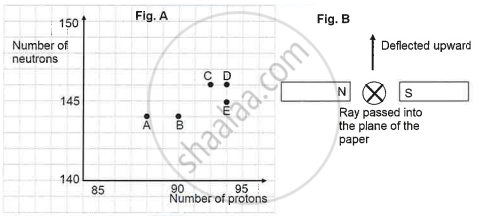Advertisements
Advertisements
प्रश्न
Observe the following figure:

If the current in the coil A is changed, will some current be induced in the coil B? Explain.
उत्तर
A current will be induced in Coil B. When there is a change in the current in Coil A, a magnetic field is associated with it. This induces a potential difference between the two coils which gives rise to a current in Coil B. This change can be noted by observing the deflection in the galvanometer.
APPEARS IN
संबंधित प्रश्न
The magnetic field inside a long straight solenoid-carrying current ______.
Describe how you will locate a current-carrying wire concealed in a wall.
Name and state the rule to determine the direction of magnetic field around a straight current-carrying conductor.
Draw the magnetic lines of force due to a circular wire carrying current.
What are the various ways in which the strength of magnetic field produced by a current-carrying circular coil can be increased?
What is a solenoid? Draw a sketch to show the magnetic field pattern produced by a current-carrying solenoid.
Name the type of magnet with which the magnetic field pattern of a current-carrying solenoid resembles
The diagram given below represents magnetic field caused by a current-carrying conductor which is:

(a) a long straight wire
(b) a circular coil
(c) a solenoid
(d) a short straight wire
A current-carrying straight wire is held in exactly vertical position. If the current passes through this wire in the vertically upward direction, what is the direction of magnetic field produced by it? Name the rule used to find the direction of magnetic field.
A current-carrying conductor is held in exactly vertical direction. In order to produce a clockwise magnetic field around the conductor, the current should passed in the conductor:
(a) from top towards bottom
(b) from left towards right
(c) from bottom towards top
(d) from right towards left
What happens when a current-carrying conductor is placed in a magnetic field?
A current-carrying conductor is placed perpendicularly in a magnetic field. Name the rule which can be used to find the direction of force acting on the conductor.
State two ways to increase the force on a current-carrying conductor in a magnetic field.
State Fleming's left-hand rule. Explain it with the help of labelled diagrams.
The force exerted on a current-carrying wire placed in a magnetic field is zero when the angle between the wire and the direction of magnetic field is:
45°
60°
90°
180°
In the simple electric motor of figure given below, the coil rotates anticlockwise as seen by the eye from the position X when current flows in the coil

Is the current flowing clockwise or anticlockwise around the coil when viewed from above?
Which way does the wire in the diagram below tend to move?

Two coils A and B of insulated wire are kept close to each other. Coil A is connected to a galvanometer while coil B is connected to a battery through a key. What would happen if:
a current is passed through coil B by plugging the key?
Explain your answer mentioning the name of the phenomenon involved.
Name three factors on which the magnitude of force on a current carrying conductor placed in a magnetic field depends and state how does the force depend on the factors stated by you.
State condition when magnitude of force on a current carrying conductor placed in a magnetic field is zero?
State condition when magnitude of force on a current carrying conductor placed in a magnetic field is maximum?
Name the following diagram and explain the concept behind it.

i) Which principle is explained in this figure?
ii) Which rule is used to find out the direction of a force in this principle?
iii) In which machine this principle is used? Draw a diagram showing working of that machine
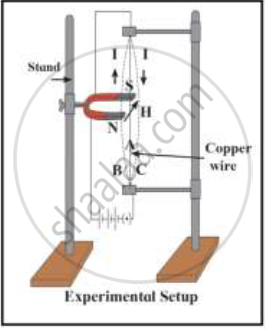
State two ways to increase the speed of rotation of a D.C. motor.
State Fleming's left handle rule.
A flat coil ABCD is freely suspended between the pole of a U-shaped permanent magnet with the plane of coil parallel to the magnetic field.
When will coil come to rest?
State under what conditions force acting on a current carrying conductor which is freely suspended in a magnetic field can be Zero.
Write Fleming’s left hand rule.
A magnetic field directed in north direction acts on an electron moving in east direction. The magnetic force on the electron will act ____________.
The diagram below shows a free conductor AB is kept in a magnetic field and is carrying current from A to B. (To avoid confusion complete path of the circuit is not shown) The direction of the force experienced by the conductor will be:
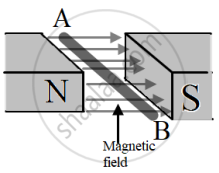
A simple motor is made in a school laboratory. A coil of wire is mounted on an axle between the poles of a horseshoe magnet, as illustrated.
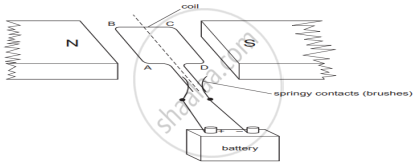
In the example above, coil ABCD is horizontal and the battery is connected as shown.
- For this position, state the direction of the force on the arm AB.
- Why does the current in the arm BC not contribute to the turning force on the coil?
Assertion (A): A magnetic field exerts a force on a moving charge in the same direction as the direction of the field itself.
Reason (R): The direction of force is given by Fleming’s left-hand rule.
An alpha particle enters a uniform magnetic field as shown. The direction of force experienced by the alpha particle is ______.
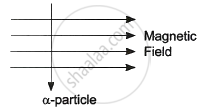
Two LED bulbs of 10W and 5W are connected in series. If the current flowing through 5W bulb is 0.005A, the current flowing through 10W bulb is ______.
|
The graph (fig A) illustrates the correlation between the number of protons (x-axis) and the number of neutrons (y-axis) for elements A, B, C, D, and E in the periodic table. These elements are denoted by the letters rather than their conventional symbols. When the element C, depicted in the graph, undergoes radioactive decay, it releases radioactive rays. When these rays are directed into the plane of the paper in the presence of a magnetic field, as indicated in the fig B, they experience deflection, causing them to move upwards.
|
Name the law used to identify the radioactive radiation emitted by the element.
